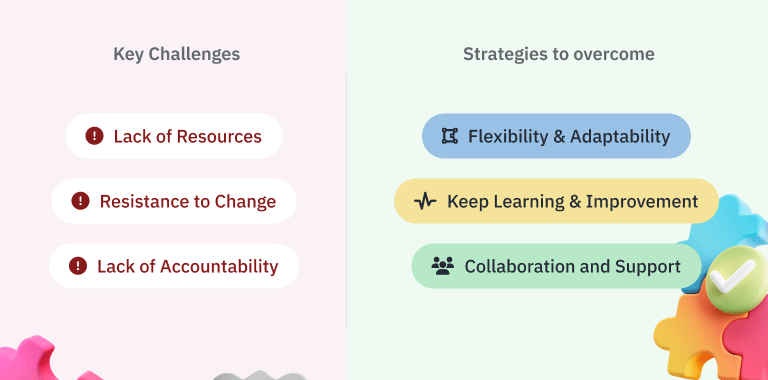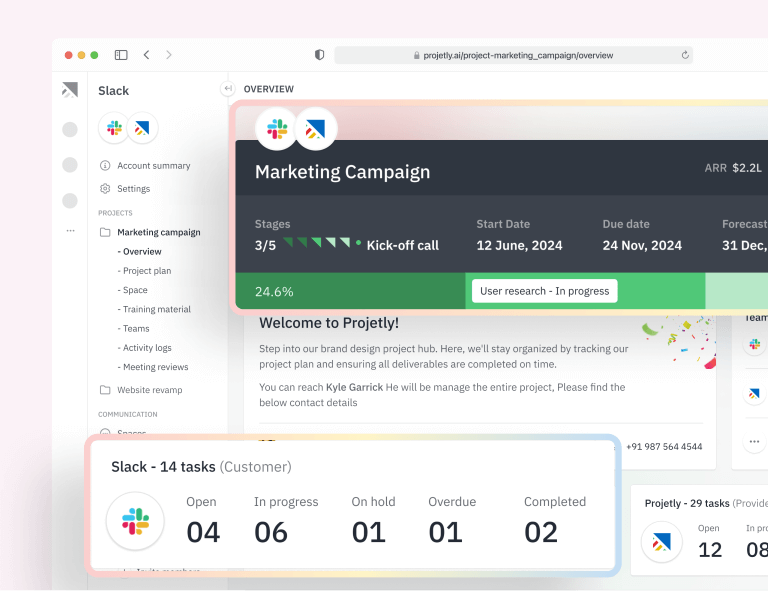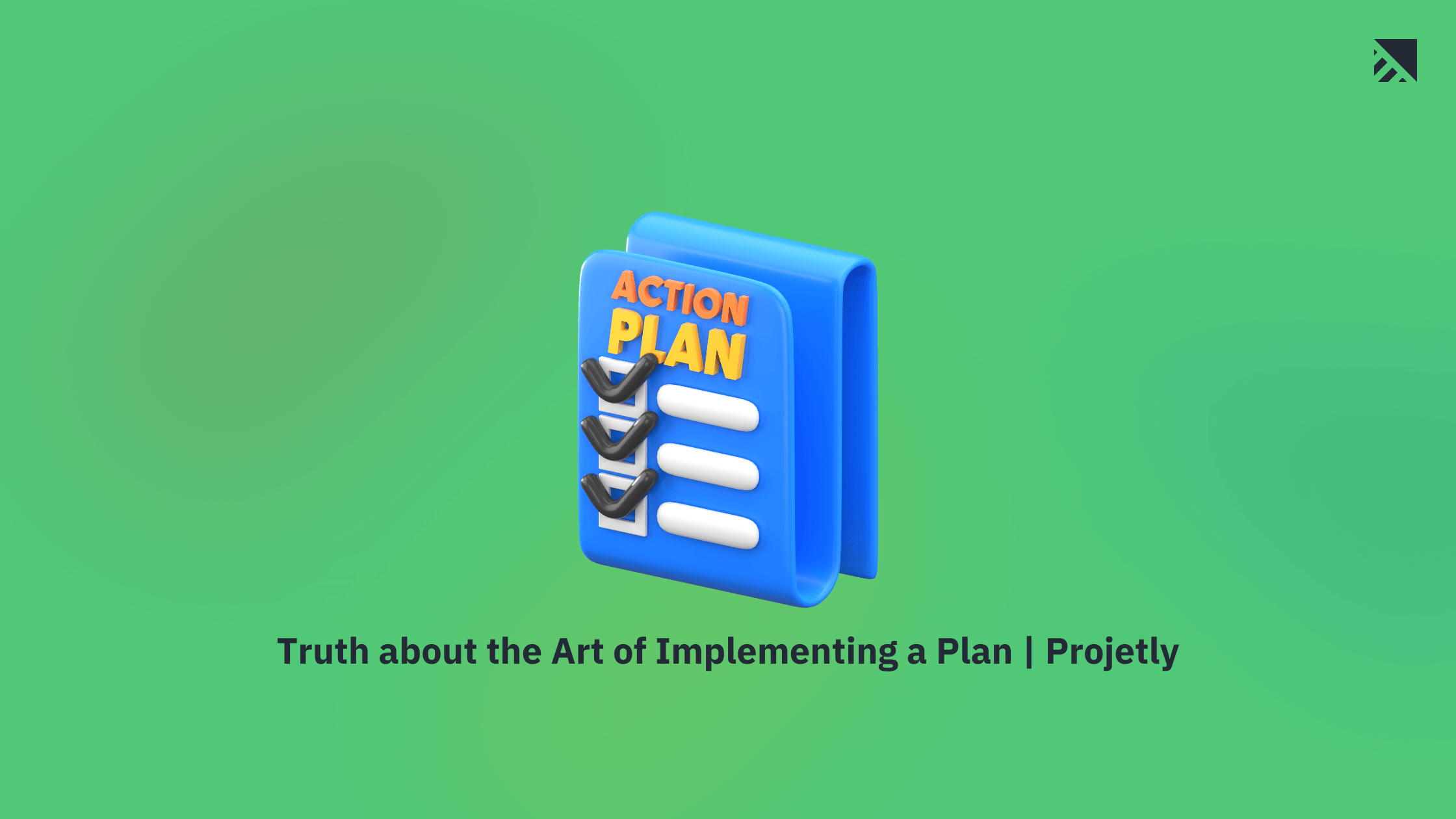Implementing a plan is not just a routine checklist in project management; it’s the backbone of success. Whether you’re launching a new product, executing a marketing campaign, or, managing the Customer Onboarding Project of a CRM Tool, having a well-structured plan can make all the difference. While the importance of planning is undeniable, the true test lies in putting that plan into action.
In this blog, we’ll delve deep into the art of implementing a plan and how it can be a game-changer for your projects. We also discuss the key aspects of successful plan implementation, offering insights into the challenges and strategies involved in bringing your project vision to life. Get ready to unleash the power of implementing a plan and take your success to new heights.
Table of Contents

Importance of Implementing a Plan for a project
Implementing a plan is crucial when undertaking a project, whether a personal goal or a business initiative. Without a plan, you risk wasting time, resources, and energy on tasks that may not contribute to your desired outcome. A well-implemented plan ensures that you stay focused, organized, and on track throughout the project.
Importance of Implementing a Plan for a project

Implementing a plan is crucial when undertaking a project, whether a personal goal or a business initiative. Without a plan, you risk wasting time, resources, and energy on tasks that may not contribute to your desired outcome. A well-implemented plan ensures that you stay focused, organized, and on track throughout the project.
Preview of Key Points
Before we delve deeper into the benefits of implementing a plan, let’s take a moment to preview the key points we will cover in this guide:
- Understanding the Importance of Project Planning
- Elements Involved in Implementing a Plan
- Strategies for Successful Plan Implementation
- Overcoming Challenges in Implementing a Plan
- Monitoring and Evaluating Plan Progress
- Key Takeaways and Lessons
Understanding the Importance of Project Planning
Project planning is the foundation upon which successful projects are built. It involves defining the project’s objectives, identifying the tasks required to achieve them, and establishing a timeline for completion. Invest time and effort into thorough project planning to set yourself up for success from the beginning.
Significance of Project Plan
Imagine setting out on a road trip without a map or GPS. You might eventually reach your destination, but chances are you’ll encounter detours, delays, and confusion along the way. A comprehensive project plan outlines objectives, strategies, and deliverables. It acts as a roadmap, providing clarity and direction to all stakeholders involved. A well-crafted project plan ensures everyone works towards a common goal and helps identify potential risks and challenges for proactive mitigation strategies.
Role as a Roadmap for Project Success
Implementing a plan is like having a roadmap that guides you toward your destination. A project plan breaks down the project into smaller, manageable tasks, ensuring that you stay focused and organized. In the case of the CRM Tool Customer Onboarding Project, the plan not only outlines tasks but also defines milestones, deliverables, timeline, and success criteria, keeping everyone on the same page. Following a well-defined plan can minimize the chances of getting lost or overwhelmed, increasing your chances of project success.
Organizing Tasks and Resources
One of the fundamental aspects of project planning is organizing tasks and resources efficiently. This involves breaking down the project into manageable tasks, assigning responsibilities, estimating resource requirements, and creating a timeline. For instance, in our Customer Onboarding Project, tasks such as client discovery sessions, customization of the CRM tool, training sessions, and post-onboarding support are meticulously organized within the plan.
Elements Involved in Implementing a Plan
Implementing a plan involves several key elements that contribute to its success. Let’s explore these elements in more detail:

Clear Objectives of the Project
Every successful project starts with clear and achievable objectives. These objectives serve as the foundation upon which the entire project plan is built. By defining the desired outcomes and success criteria upfront, you can align your efforts toward achieving those goals. Clarity in objectives also helps in setting realistic expectations and measuring progress accurately. In the case of our Customer Onboarding Project, the primary objective is to ensure a smooth transition for clients onto the CRM tool, maximize user adoption, and deliver exceptional customer experience from day one.
Contingency Planning and Risk Assessment
Every plan is flawed, and unforeseen challenges are bound to arise during a project. That’s where contingency planning and risk assessment come into play. One effective way to minimize unforeseen events’ adverse effects is to identify potential risks and develop contingency plans proactively. By taking this approach, you can increase the likelihood that your project will stay on track, even if unexpected hurdles arise. In our CRM Tool Customer Onboarding Project, risks such as technical glitches, client resistance to change, and resource constraints are assessed, and contingency plans are devised to address these challenges proactively.
Strategies for Successful Plan Implementation
Implementing a plan requires more than just creating a document. It involves strategic thinking and a systematic approach. Here are some strategies to ensure successful plan implementation:
Breaking Down a Project Plan:
Breaking down a project plan into smaller, manageable tasks is key to successful implementation. This involves creating a work breakdown structure (WBS), which hierarchically decomposes the project into phases, deliverables, and tasks. For example, in our Customer Onboarding Project, the WBS includes phases like pre-onboarding preparations, client customization, training and support, and post-onboarding evaluation.
Creating an Action Plan:
An action plan translates the project plan into actionable steps with specific timelines, responsible parties, and dependencies. It outlines who does what, when it needs to be done, and how tasks are interconnected. In our CRM Tool Customer Onboarding Project, the action plan includes tasks such as conducting client needs analysis, configuring the CRM tool based on requirements, scheduling training sessions, and setting up post-onboarding feedback mechanisms.
Communication and Collaboration:
Enabling open communication and collaboration among team members are paramount to plan implementation success. This involves establishing clear channels of communication, fostering collaboration among team members, and keeping stakeholders informed and engaged throughout the project. In our Customer Onboarding Project, regular meetings, progress updates, and feedback loops ensure seamless communication and collaboration, enhancing project outcomes.
Role of Leadership:
Effective leadership plays a crucial role in implementing a plan successfully. Leaders should provide guidance, support, and motivation to their team members, ensuring everyone is working towards a common goal. In our CRM Tool Customer Onboarding Project, leadership involves decision-making, problem-solving, resource allocation, and resolving conflicts, all aimed at keeping the project on track and delivering value to clients.
Overcoming Challenges in Implementing a Plan
Implementing a plan has challenges, but one can solve these obstacles and succeed with the right strategies and mindset. Let’s explore a few challenges and strategies to overcome them during plan implementation.

Common Challenges
- Lack of Resources: Limited resources, such as budget, workforce, or technology, can pose a significant challenge during plan implementation. To overcome this, prioritize tasks, explore alternative solutions, and leverage existing resources effectively.
- Resistance to Change: People often resist change, hindering plan implementation. Overcome resistance by communicating the plan’s benefits, involving stakeholders in decision-making, and proactively addressing concerns.
- Lack of Accountability: Without clear accountability, plan implementation can suffer. Establish well-defined roles, responsibilities, and expectations from the beginning. Regular check-ins and performance evaluations help in ensuring accountability.
Strategies for Overcoming Challenges
- Flexibility and Adaptability: Stay flexible and adaptable in facing challenges. Be open to adjusting your plan as needed while keeping your end goal in mind. Embrace change as an opportunity for growth and improvement.
- Continuous Learning and Improvement: Treat challenges as learning opportunities. Analyze what went wrong, identify areas for improvement, and incorporate those learnings into your plan. This iterative approach ensures that your plan becomes more robust over time.
- Collaboration and Support: Encourage a culture of collaboration and support within your team. Encourage open communication, provide resources and training, and celebrate successes together. A united team can overcome any challenge that comes their way.

Monitoring and Evaluating Plan Progress
When it comes to achieving success, implementing a plan is crucial. However, the work doesn’t stop once the plan is in place. It is equally important to monitor and evaluate your plan’s progress to ensure that you stay on track and make necessary adjustments.

Importance of Monitoring
Monitoring your plan’s progress is essential for several reasons. First, it allows you to identify any issues or obstacles that may arise. By regularly reviewing your plan, you can spot any potential problems early on and address them before they become major roadblocks.
Secondly, monitoring provides valuable insights into what is working and what isn’t. It helps you determine which strategies or tactics produce the desired results and which may need to be revised or replaced. This data-oriented approach enables you to make informed decisions and optimize your plan for maximum effectiveness.
Lastly, monitoring reinforces accountability. When you consistently track your progress, you hold yourself and your team accountable for achieving the goals set out in your plan. It creates a sense of responsibility and motivation to stay focused and committed to the plan’s execution.
Tracking KPIs
Key Performance Indicators (KPIs) are essential metrics that allow you to measure the success of your plan. They provide quantifiable data that helps you evaluate your progress and help you be on track to achieving your goals.
Choosing metrics to align with your objectives and reflect the outcomes you want to achieve is essential when selecting KPIs. These could include sales revenue, customer satisfaction ratings, website traffic, or any other measurable factor relevant to your plan.
Regularly tracking and analyzing your KPIs provides valuable insights into the effectiveness of your strategies. It allows you to identify patterns and areas for improvement. By monitoring your KPIs, you can make data-driven decisions and adjust your plan accordingly to optimize your chances of success. Relevant KPIs for our Customer Onboarding Project may include:
- Time to onboard new clients
- User engagement and activity levels on the CRM tool
- Client satisfaction ratings
- Revenue generated from onboarded clients
- Return on investment (ROI) from the onboarding process
Project managers gain insights into progress, identify areas of improvement, and make data-driven decisions to optimize outcomes by tracking these KPIs.
Feedback and Evaluation
In addition to monitoring KPIs, seeking feedback and conducting evaluations are crucial to assessing plan progress. Input from stakeholders, team members, and customers can provide valuable perspectives and insights that data may need to be captured.
Feedback helps identify blind spots, uncover new opportunities, and improve your plan’s execution. A culture that encourages open communication and constructive feedback is essential. Listen to your input and consider how it can inform your decision-making process.
Evaluation involves systematically reviewing your plan’s performance against the intended outcomes. It helps you assess the impact of your strategies and tactics and determine if adjustments are necessary. Evaluations can be conducted at predetermined milestones or periodically throughout the plan’s execution.
Incorporating feedback and evaluation into your monitoring process ensures a holistic assessment of your plan’s progress. This comprehensive approach enhances your ability to make informed decisions and adapt strategies.

Key Takeaways and Lessons
Throughout your journey of implementing and monitoring a plan, you will encounter valuable lessons and key takeaways that can further enhance your chances of success. Here are a few essential insights to keep in mind:
- Clear objectives are the foundation of a successful project plan.
- Risk assessment and contingency planning are essential for mitigating challenges.
- Communication, collaboration, and leadership play critical roles in plan implementation.
- Flexibility, adaptability, and continuous monitoring are key to overcoming challenges.
- Tracking KPIs and gathering feedback drive continuous improvement and success.
Applying these takeaways to your projects can significantly enhance plan implementation and project outcomes.
Conclusion
Implementing a plan is a powerful tool for achieving success, but it doesn’t guarantee results on its own. Monitoring and evaluating your plan’s progress is essential to ensure that you stay on track and make necessary adjustments. By tracking KPIs, seeking feedback, and conducting evaluations, you can optimize your plan’s effectiveness and increase your chances of success. Remember to remain flexible and consistent, and learn from both failures and successes along the way. With a well-executed plan and a commitment to continuous improvement, you will unleash the power of success.
Summary of Key Points
- Monitoring your plan’s progress allows you to identify issues, spot opportunities, and ensure accountability. By regularly reviewing your plan, you can proactively address problems and ensure everyone involved stays focused on achieving the set goals.
- Tracking KPIs provides quantifiable data to evaluate your plan’s effectiveness and make data-driven decisions. KPIs (Key Performance Indicators) help you measure progress and determine if your strategies work as intended.
- Feedback and evaluation provide valuable perspectives and insights that complement quantitative analysis. Incorporating input from stakeholders and team members and assessments allows you to understand your plan’s effectiveness.
- Flexibility, consistency, and learning from failures and successes are key takeaways to remember in your journey toward success. A successful plan should be adaptable to changing circumstances but also require consistent monitoring and adjustments to stay on track. Embrace both successes and failures as opportunities to learn and improve.
Reinforcing the Importance of Implementing a Plan
The importance of implementing a plan cannot be overstated. Without a plan, you may be aimlessly moving from task to task without clear direction or purpose. A well-thought-out plan provides a roadmap for success, guiding your actions and ensuring you stay focused and on track. It helps you prioritize your efforts, allocate resources effectively, and make informed decisions.
A plan also provides a sense of structure and organization, reducing stress and increasing productivity. Having a plan means you’re clear on the necessary actions and their timing, removing uncertainty and enabling you to operate more effectively.
Furthermore, implementing a plan demonstrates your commitment and dedication to achieving your goals. It shows that you are proactive and take your objectives seriously. This mindset enhances your chances of success and inspires confidence in others, whether your team members, stakeholders, or customers.
In summary, implementing a plan is the foundation for success. It provides clarity, structure, and accountability, enabling you to progress toward your goals in a focused and efficient manner.
Encouraging Application of Strategies
Now that you understand the importance of implementing a plan, it’s time to take action. Here are some strategies to help you effectively implement and execute your plan:

- Clearly define your goals: Start by setting clear, specific, and measurable goals. It provides a clear direction and purpose for your plan.
- Break it down: Divide your plan into manageable tasks or milestones. This way, it is easier to track progress and stay motivated.
- Assign responsibilities: Assign responsibilities to individuals and teams involved in the plan. This ensures accountability and collaboration.
- Communicate and collaborate: Establish effective communication channels to keep everyone informed and aligned. Encourage collaboration and open dialogue to foster innovation and problem-solving.
- Regularly monitor progress: Monitor your plan’s progress by tracking KPIs, seeking feedback, and conducting evaluations. This helps identify issues and make the necessary adjustments.
- Stay adaptable: Always be prepared to adjust your plan as needed. Embrace change and remain flexible to seize new opportunities or address unforeseen challenges.
- Celebrate milestones: Celebrate achievements and milestones along the way. It is essential to boost morale and maintain motivation throughout the plan’s execution.
Additional Resources
To further enhance your understanding and application of plan implementation strategies, consider exploring the following resources:
- Project Management Institute (PMI) – https://www.pmi.org/
- Agile Alliance – https://www.agilealliance.org/
- Harvard Business Review (HBR) – https://hbr.org/topic/project-management
These resources offer valuable insights, best practices, case studies, and tools to support your journey towards mastering success in plan implementation.
Implementing a Plan: Case Study – Customer Onboarding Project of a CRM Tool
To further illustrate the concepts discussed, let’s delve deeper into the Customer Onboarding Project of a CRM Tool. This case study will provide real-world insights into how the principles of effective plan implementation were applied and the outcomes achieved.
This concludes our in-depth exploration of the art of implementing a plan, using the Customer Onboarding Project as a practical case study. May your future projects be marked by success, innovation, and impactful implementation. Happy planning and executing!
Frwquently Asked Questions
What is the essence of implementing a plan effectively?
The essence of implementing a plan lies in thorough preparation, clear communication, and continuous monitoring. It involves setting realistic goals, allocating appropriate resources, establishing timelines, and adapting to changes and unforeseen challenges.
What are common misconceptions about plan implementation?
Common misconceptions include the belief that the hard work is over once an implementation plan is created and that following the plan rigidly guarantees success. That implementation is solely the responsibility of project managers. Successful implementation requires ongoing effort, flexibility, and collaboration from the entire team.
How can one ensure stakeholder buy-in during the implementation phase?
Ensuring stakeholder buy-in involves:
* Engaging stakeholders early in the planning process
* Communicating the plan’s benefits and goals
* Addressing any concerns or objections
* Involving them in key decision-making processes
* Regular updates and transparency also help maintain their support and commitment.
What role does adaptability play in the art of implementing a plan?
Adaptability is crucial as it allows the team to respond effectively to unexpected challenges and changes in circumstances. Being adaptable means regularly reviewing progress, being open to feedback, and making necessary adjustments to the plan to stay on track and achieve the desired outcomes.
What are the key challenges faced during plan implementation, and how can they be overcome?
Key challenges include resource limitations, resistance to change, communication breakdowns, and scope creep. These can be overcome by ensuring adequate resource planning, fostering a positive change culture, maintaining clear and consistent communication, and setting and enforcing clear boundaries for the project’s scope. Regular monitoring and contingency plans also help address these challenges effectively.





7 Comments
Beth
Way cool! Some very valid points! I appreciate you penning this post and the rest of the website is
extremely good.
Soumya N
Thank you. Glad that you liked it.